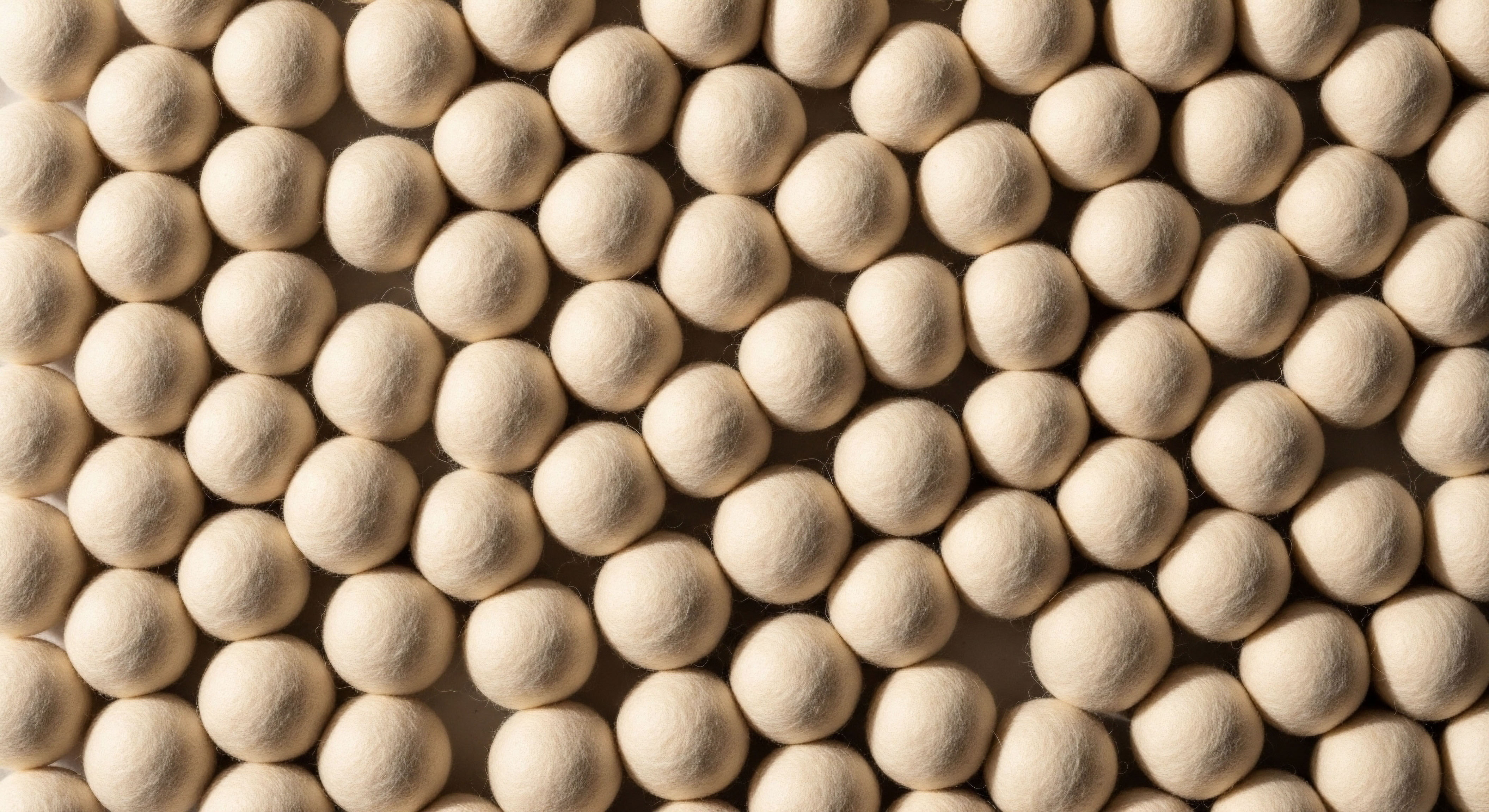

Fundamentals
The feeling of being at war with your own digestive system is a heavy burden. It is a state of internal friction where bloating, discomfort, and unpredictable symptoms dictate the terms of your daily life. This experience, far from being a simple matter of digestion, is a profound signal from the body’s core.
It speaks to a disruption in a system so foundational that its echoes are felt in your energy levels, your mood, and your overall sense of vitality. Your journey toward understanding and resolving these issues begins with a powerful shift in perspective.
The goal is to see your body as an integrated biological system, a network of communication where the gut acts as a central hub. Within this framework, therapeutic peptides like Body Protection Compound-157 (BPC-157) represent a significant advancement. They are targeted biological tools designed to work with your body’s innate healing mechanisms, offering a precise way to support cellular repair and restore integrity to the gastrointestinal tract.
These peptides are derived from proteins naturally present in the body, specifically in human gastric juice. BPC-157 is a sequence of 15 amino acids that has demonstrated a remarkable capacity to accelerate the healing of tissues, including the gut lining, muscle, and tendons.
It functions by promoting angiogenesis, the formation of new blood vessels, which is essential for delivering nutrients and oxygen to damaged areas. Think of it as dispatching a highly specialized construction crew directly to a site of injury, equipped with the blueprints and materials to rebuild.
The peptide KPV, a sequence of three amino acids, offers a complementary action. Its primary role is to modulate the immune response, specifically by calming inflammation. Chronic inflammation is a key driver of many gut-related disorders, creating a persistent state of alert that prevents proper healing. KPV acts as a diplomatic envoy, de-escalating the inflammatory response so that the restorative work can proceed without interference.
Gut-healing peptides function as precise biological signals that activate the body’s own repair and anti-inflammatory processes at a cellular level.
The true potential of these peptides is realized when they are introduced into a biological environment that is primed for healing. Administering a sophisticated therapeutic agent into a system that remains inflamed, undernourished, and under stress is like sending that expert construction crew into a building with a faulty foundation and no electrical power.
The work will be slow, inefficient, and ultimately compromised. This is where lifestyle and diet become indispensable allies. The foods you consume and the daily habits you cultivate create the foundational conditions within your body.
They supply the raw materials for repair, regulate the inflammatory background noise, and ensure the communication lines between the gut and the rest of the body, including the endocrine system, are clear and functional. Enhancing the efficacy of gut-healing peptides, therefore, is an exercise in creating a synergistic system where targeted therapeutics are supported by a foundational state of wellness.
This integrated approach allows you to move from simply managing symptoms to actively rebuilding the very fabric of your health from the inside out.

The Gut as an Endocrine Command Center
Your gastrointestinal tract is much more than a digestive tube. It is a highly active and intelligent endocrine organ, meaning it produces and responds to hormones. This continuous chemical dialogue influences your metabolism, mood, and immune function.
The cells lining your gut, known as enteroendocrine cells, secrete more than 20 different hormones in response to the food you eat and the state of your gut microbiome. These signals travel throughout the body, regulating insulin secretion, appetite, and even the production of stress hormones.
When the gut lining is compromised, a condition often referred to as increased intestinal permeability or “leaky gut,” this finely tuned communication system breaks down. Undigested food particles and microbial toxins can pass into the bloodstream, triggering a systemic inflammatory response.
This inflammation is a root cause of many chronic health issues and directly interferes with the function of other endocrine glands, such as the thyroid and adrenal glands. Peptides like BPC-157 work to repair the physical structure of the gut barrier, sealing these gaps and restoring its integrity.
By doing so, they help to quiet the inflammatory cascade at its source. A diet rich in anti-inflammatory compounds and nutrients that support the gut lining amplifies this effect, creating a powerful combination that restores order to the body’s hormonal command center.

Understanding the Mechanism of Peptides
To appreciate how lifestyle changes can enhance peptide therapy, it is useful to understand how these molecules work at a basic level. Peptides are short chains of amino acids, the building blocks of proteins. They act as signaling molecules, binding to specific receptors on the surface of cells and instructing them to perform certain tasks.
BPC-157, for instance, has been shown to interact with the growth hormone receptor and to upregulate the expression of genes involved in cellular repair and blood vessel growth. KPV, on the other hand, interacts with pathways inside the cell to reduce the production of inflammatory cytokines. These actions are highly specific.
The peptides do not introduce a foreign function to the body. They amplify and direct the body’s own pre-existing healing capabilities. The lifestyle and dietary strategies discussed in the following sections are designed to support these same pathways.
For example, consuming foods rich in polyphenols can also help to reduce inflammation, while ensuring an adequate intake of protein provides the necessary amino acids for the rebuilding process that BPC-157 initiates. This creates a multi-pronged approach where the peptides provide the specific instructions for repair, and the diet provides the resources and a favorable environment for those instructions to be carried out effectively.


Intermediate
Moving beyond the foundational understanding of gut-healing peptides, the intermediate approach involves the deliberate and strategic implementation of specific dietary and lifestyle protocols. This is where the abstract concept of “creating a supportive environment” translates into concrete, actionable steps.
The objective is to systematically reduce the biochemical burdens that hinder the work of peptides like BPC-157 and KPV, while simultaneously providing the precise nutritional cofactors that amplify their regenerative effects. This process involves a two-pronged strategy. First, the removal of inflammatory triggers and gut irritants.
Second, the intentional inclusion of foods and nutrients that actively support mucosal healing, modulate the microbiome, and regulate the body’s stress response systems. This is a clinical calibration of your internal environment, designed to maximize the return on your investment in peptide therapy. By aligning your daily habits with the biological goals of the treatment, you create a powerful synergy that can accelerate healing and lead to more profound and lasting results.

Architecting a Pro-Repair Dietary Protocol
A diet designed to enhance peptide efficacy is built on the principle of providing the body with the essential building blocks for tissue repair while minimizing inflammatory signals. This goes beyond a generic “healthy diet” and focuses on specific food components that support the gut lining and its microbial inhabitants.

Core Nutritional Pillars
The following components form the bedrock of a gut-supportive diet. Their inclusion provides the raw materials and signaling molecules that work in concert with healing peptides.
- Amino Acids for Mucosal Integrity ∞ The gut lining has a high turnover rate, requiring a constant supply of amino acids for regeneration. Glycine, proline, and glutamine are particularly important. Bone broth is an excellent source of glycine and proline, while glutamine can be found in cabbage, fish, and grass-fed beef. These amino acids are the literal bricks and mortar that BPC-157 helps to organize and assemble.
- Polyphenol-Rich Foods for Inflammation Control ∞ Polyphenols are compounds found in plants that have potent anti-inflammatory and antioxidant properties. They help to quell the systemic inflammation that KPV targets. Sources include berries, dark leafy greens, green tea, and extra virgin olive oil. Consuming a wide variety of colorful plants ensures a broad spectrum of these protective compounds.
- Prebiotic Fibers for Microbiome Support ∞ Prebiotics are types of fiber that feed the beneficial bacteria in your gut. A healthy microbiome produces short-chain fatty acids (SCFAs) like butyrate, which is a primary fuel source for the cells of the colon and has anti-inflammatory effects. Excellent sources of prebiotic fiber include asparagus, garlic, onions, Jerusalem artichokes, and slightly under-ripe bananas.
- Omega-3 Fatty Acids for Systemic Regulation ∞ The balance between omega-3 and omega-6 fatty acids is a key regulator of the body’s inflammatory tone. A diet high in processed foods and industrial seed oils tends to be rich in pro-inflammatory omega-6s. Increasing the intake of anti-inflammatory omega-3s from sources like wild-caught salmon, sardines, mackerel, and walnuts helps to create a less inflammatory internal environment, making the job of peptides easier.

What Is the Best Diet to Follow?
While the nutritional pillars above are universally beneficial, some individuals may find that a more structured dietary template is necessary, especially in the initial phases of gut healing. The choice of diet should be guided by individual symptoms and, ideally, clinical testing. The table below compares two common approaches.
| Dietary Approach | Primary Mechanism | Best Suited For | Considerations |
|---|---|---|---|
| Low FODMAP Diet | Reduces fermentable carbohydrates that can cause gas, bloating, and pain in sensitive individuals. This lowers luminal irritation. | Individuals with significant bloating, gas, and symptoms characteristic of Irritable Bowel Syndrome (IBS). | This is intended as a short-term elimination diet to identify trigger foods, not a permanent lifestyle. Long-term use can negatively affect microbiome diversity. |
| Autoimmune Protocol (AIP) | Eliminates common immunogenic foods like grains, dairy, nuts, seeds, and nightshades to reduce immune system activation and gut inflammation. | Individuals with diagnosed autoimmune conditions or those with signs of significant immune dysregulation and gut permeability. | AIP is highly restrictive and requires careful planning to ensure nutritional adequacy. It is a therapeutic tool for calming the immune system. |

Regulating the Stress Axis for Optimal Healing
Chronic stress is a formidable obstacle to gut healing. The body’s primary stress hormone, cortisol, has a direct impact on the gastrointestinal system. Elevated cortisol levels can increase gut permeability, alter the composition of the gut microbiome, and suppress the immune system’s healing functions. This creates a physiological environment that directly counteracts the intended effects of BPC-157 and KPV. Therefore, managing the stress response is a non-negotiable component of any serious gut-healing protocol.
Actively managing the body’s stress response is as critical to gut repair as any dietary change or supplement.
Lifestyle practices that activate the parasympathetic nervous system, the body’s “rest and digest” mode, can effectively lower cortisol and create a state more conducive to healing. These are not passive activities but active interventions in your own physiology.
- Controlled Breathing Practices ∞ Techniques like box breathing (inhaling for four seconds, holding for four, exhaling for four, holding for four) have been shown to directly influence heart rate variability and promote a state of calm. Practicing for just 5-10 minutes per day can have a measurable impact on your stress physiology.
- Sleep Optimization ∞ Sleep is when the majority of the body’s repair processes occur. Poor sleep disrupts hormonal rhythms and increases inflammation. Establishing a consistent sleep schedule, ensuring a dark and cool sleeping environment, and avoiding blue light from screens before bed are critical steps. Quality sleep allows peptides to work on a clean and prepared canvas.
- Mindful Movement ∞ Strenuous exercise can be a form of stress on the body, particularly during a phase of active gut healing. Gentle, mindful movement like yoga, tai chi, and walking in nature can reduce stress and improve circulation to the gut without overburdening the system. This type of activity supports the delivery of peptides and nutrients to the tissues that need them most.


Academic
An academic exploration of enhancing gut-healing peptide efficacy requires a shift in focus from protocols to pathways. The central thesis is that the therapeutic bioactivity of peptides like BPC-157 and KPV is mechanistically intertwined with the cellular and molecular environment shaped by diet and lifestyle. This environment is not a passive backdrop.
It is an active participant in the signaling cascades that govern tissue regeneration and immunomodulation. The efficacy of an exogenous peptide is ultimately determined by the receptivity and resource availability of the target tissue. This receptivity is governed by factors such as local inflammation, cellular energy status, and the presence of specific nutritional cofactors that participate in the downstream effects of peptide receptor activation.
Therefore, a truly optimized therapeutic strategy involves the precise manipulation of these endogenous factors to create a state of maximum biological synergy. This section will examine the molecular intersections between specific dietary components, stress-mediated physiological states, and the known mechanisms of action of gut-healing peptides.

Molecular Synergy between Diet and Peptides
The concept of synergy can be demonstrated at the level of intracellular signaling. Many of the benefits attributed to a “healthy diet” are, at their core, the result of food-derived molecules influencing the same genetic and protein-level switches that peptides target. This creates a scenario of convergent signaling, where multiple inputs amplify a desired biological output.

Butyrate and the Epigenetics of Gut Healing
One of the most compelling examples of this synergy is the relationship between dietary fiber, the microbial metabolite butyrate, and gut health. Butyrate, a short-chain fatty acid (SCFA) produced by the fermentation of resistant starch and fiber by gut bacteria, is a primary energy source for colonocytes. Its benefits extend far beyond simple fuel provision.
Butyrate is a potent histone deacetylase (HDAC) inhibitor. By inhibiting HDACs, butyrate alters the chromatin structure of DNA, making certain genes more accessible for transcription. This epigenetic modification can increase the expression of genes involved in the formation of tight junctions, the protein complexes that seal the space between intestinal epithelial cells.
A diet rich in diverse fibers directly fuels the production of butyrate, thus promoting the baseline integrity of the gut barrier. When a peptide like BPC-157 is introduced, which also promotes the expression of proteins involved in cell adhesion and barrier function, it acts on a system that is already epigenetically primed for repair.
The peptide’s signal to “rebuild” is received by cells that have been given both the fuel (butyrate) and the genetic permission (via HDAC inhibition) to execute the command efficiently.

Polyphenols and the Nrf2 Pathway
Another point of convergence is the Nrf2 pathway, a master regulator of the body’s antioxidant response. Oxidative stress is a key feature of inflammatory gut conditions, contributing to cellular damage and impeding repair. Many plant-derived polyphenols, such as sulforaphane from broccoli sprouts and curcumin from turmeric, are potent activators of the Nrf2 pathway.
Activation of Nrf2 leads to the transcription of a host of antioxidant and cytoprotective genes. Peptides like KPV work to reduce inflammation by inhibiting pro-inflammatory signaling pathways like NF-κB. These two actions are complementary. The polyphenols, via Nrf2, enhance the cell’s intrinsic defense and cleanup capabilities, reducing the overall burden of oxidative stress.
Simultaneously, KPV reduces the production of new inflammatory triggers. This dual approach, one that builds cellular resilience and one that quells the inflammatory fire, is more effective than either strategy alone. The diet effectively improves the cell’s ability to cope with stress, while the peptide reduces the sources of that stress.

How Does Gut Health Impact Hormone Optimization Protocols?
The gastrointestinal system is a critical site for hormone metabolism and regulation. A compromised gut can significantly impact the efficacy and safety of endocrine therapies, including Testosterone Replacement Therapy (TRT) for both men and women. The connection operates through several mechanisms, making gut health a foundational consideration in any hormonal optimization protocol.
The estrobolome, a collection of gut bacteria capable of metabolizing estrogens, is a prime example. These microbes produce an enzyme called beta-glucuronidase. This enzyme can deconjugate estrogens that have been processed by the liver and prepared for excretion. This deconjugation allows the estrogens to be reabsorbed into circulation.
In a state of gut dysbiosis, an imbalance in the gut microbiota, the activity of beta-glucuronidase can be altered. Elevated levels can lead to an increased reabsorption of estrogen, potentially contributing to estrogen dominance in both men and women on TRT.
This can manifest as side effects like gynecomastia or mood changes in men, or an altered estrogen/progesterone balance in women. A diet that supports a healthy microbiome can help to regulate estrobolome activity, thereby supporting a more predictable and balanced hormonal environment during therapy. Anastrozole, often prescribed with TRT to block estrogen conversion, manages the symptoms. A healthy gut addresses a root cause of estrogen recirculation.
Furthermore, systemic inflammation originating from a permeable gut can blunt the sensitivity of hormone receptors throughout the body. Inflammatory cytokines can interfere with the signaling cascade that occurs after a hormone binds to its receptor. This means that even with optimal hormone levels in the blood, the target tissues may not be able to respond effectively.
By using gut-healing peptides and supportive dietary strategies to resolve gut inflammation, one can improve tissue sensitivity to hormonal therapies, potentially allowing for lower effective doses and better clinical outcomes.
| Nutrient/Compound | Molecular Contribution to Gut Repair | Synergistic Peptide | Clinical Relevance |
|---|---|---|---|
| Zinc | Cofactor for enzymes involved in cell division and repair. Modulates tight junction integrity. | BPC-157 | Essential for the rapid cell turnover required for healing the gut lining that BPC-157 stimulates. |
| Vitamin A (Retinoic Acid) | Regulates the differentiation of intestinal epithelial cells and influences gut-homing lymphocytes. | KPV | Supports immune tolerance in the gut, complementing KPV’s anti-inflammatory action. |
| Quercetin | A flavonoid that stabilizes mast cells, reducing histamine release. Possesses antioxidant properties. | KPV | Reduces allergic and inflammatory responses in the gut, working alongside KPV to lower overall inflammation. |
| Collagen Peptides | Provides high concentrations of glycine and proline, key amino acids for connective tissue and mucosal lining. | BPC-157 | Supplies the direct structural components needed for the rebuilding process initiated by BPC-157. |

References
- Sikirić, Petar, et al. “Brain-gut axis and pentadecapeptide BPC 157 ∞ theoretical and practical implications.” Current Neuropharmacology 14.8 (2016) ∞ 857-865.
- Seiwerth, Sven, et al. “BPC 157 and standard angiogenic growth factors. Gut-brain axis.” Current medicinal chemistry 25.18 (2018) ∞ 1972-1989.
- Dalmasso, G. et al. “The alpha-melanocyte-stimulating hormone-derived peptide KPV promotes healing of colitis in mice by inhibiting inflammatory and apoptotic pathways.” Gastroenterology 132.4 (2007) ∞ 1369-1380.
- Chang, Chung-Hsun, et al. “The promoting effect of pentadecapeptide BPC 157 on tendon healing involves tendon outgrowth, cell survival, and cell migration.” Journal of applied physiology 110.3 (2011) ∞ 774-780.
- Hsieh, Ming-Jai, et al. “Therapeutic potential of pro-angiogenic BPC157 is associated with VEGFR2 activation and up-regulation.” Journal of molecular medicine 95.6 (2017) ∞ 655-667.
- Ríos-Covián, D. et al. “Intestinal short chain fatty acids and their link with diet and human health.” Frontiers in microbiology 7 (2016) ∞ 185.
- Baker, J. M. Al-Nakkash, L. & Herbst-Kralovetz, M. M. (2017). Estrogen-gut microbiome axis ∞ Physiological and clinical implications. Maturitas, 103, 45 ∞ 53.

Reflection
The information presented here provides a map of the biological terrain you are navigating. It connects the symptoms you feel to the intricate systems that govern your health. This knowledge is a powerful tool, shifting your position from a passive recipient of symptoms to an active participant in your own recovery.
The science of peptides, diet, and hormonal health offers a clear logic for why you feel the way you do and a rational path toward reclaiming function. Consider this understanding the starting point. The true work lies in applying these principles consistently, observing your body’s unique responses, and making adjustments along the way.
Your personal health journey is a dynamic process of learning and calibration. The potential for profound change is encoded in your own biology, waiting for the right signals and the right environment to be expressed.



